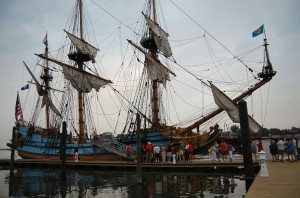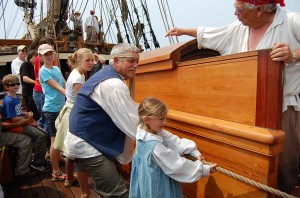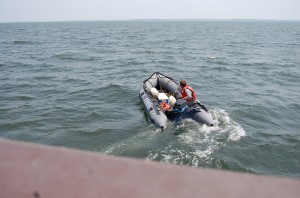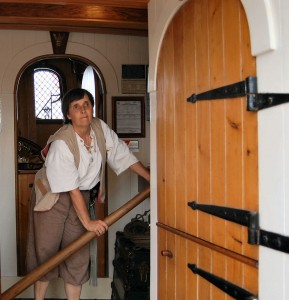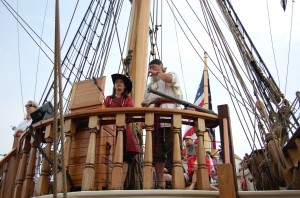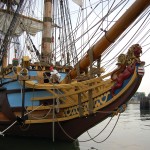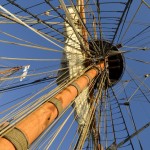As part of her 5 day stay in the Cape Charles harbor, the tall ship Kalmar Nyckel offered several opportunites for the public to board the ship for deck tours as well as four different day sail trips for up to 49 passengers per trip out into the Chesapeake Bay. We had selected the Sunday 10:30 am time slot for our sail but Sunday dawned dark andovercast, skies threatening a serious downpour at any time. The Eastern Shore definitely needs some rain so I didn’t feel but so bad but hoped it would clear up in time for the trip which included my husband, daughter, son-in-law and youngest granddaughter as well as myself. But when we arrived at the dock the crew informed everyone in line on the pier that the Captain was still monitoring the weather to decide if it would be a go or no-go. Fortunately it began to clear and the crew allowed us to board, everyone excited to sail on a ship which is a faithful reproduction of an early 1600’s Dutch pinnace. Boasting about 8 miles of rigging, three enormous masts and nearly 7,000 sq.ft. of sail, the Kalmar Nyckel is a most impressive ambassador of goodwill for the state of Delaware. It is near what is now Wilmington that her namesake first landed, on behalf of the Swedish Crown naming the area “New Sweden”, the first of four round trips she would make from Sweden to “New Sweden” before she was refitted as a warship in 1638.
It didn’t take long to get underway. Her big diesel engines fired up, ( no, they didn’t have engines in the 1600’s but hey, some things are too important to do without, even in a faithful reproduction), many orders issued from the bridge to the crew, mooring lines were cast off and away we went for our 2 1/2 hour adventure. As we left the Cape Charles harbor, 5 or 6 yachts leaving the Bay Creek Marina waved as they passed, surprised I’m sure to see this ornate beauty in their home waters. As the ship got further out into the Bay the winds started picking up and the crew made ready to hoist the sails, enlisting the help of passenger volunteers to do so. First came the instructions, terms like “avast”, “ease” and “haul” were demonstrated and practiced. Then it was time to hoist the topsails, the main top and the fore top, and this was done just as in the days of yore, pulling to the rhythm of an old sea chantey, in this case a tune called “Bully On The Deck” which has a rather captivating beat. ( I found out later that the term “bully” in sailor parlance means inebriated. ) The winds were with us and the sails filled nicely, speeding us along.
It was the wind, blowing pretty well by then, which initiated an inpromptu little training drill much to the surprise of both the crew andpassengers. I was on the upper deck, standing just behind the Captain, taking some photos when a gust swept a wide-brimmed straw hat right off a crew member’s head and sailed it smack into the water. When the Captain saw that she decided right then and there to conduct an unscheduled “man overboard” drill. In a matter of seconds alarms sounded, crew moved into various positions, on the upper deck “spotters'” grabbed binoculars and trained them on the hat, job one being to keep the “man” in sight at all times, especially difficult to do as the ship begins its turn back towards the overboard area. On the lower deck, crew threw out life preservers which in the event of a real problem are an effort to send a number of flotation devices out towards the victim in hopes that one will be grabbed. All passengers on the lower deck were asked to move towards the bow. The rubber Zodiak , which is secured to the stern, was lowered into the water, engine started and the 2nd mate and another crew member set out for the rescue. Meantime, designated crew members were busy counting passengers, counting crew and talleying numbers to make sure everyone was accounted for, that only one “man” had gone overboard. All of this was done quickly and efficiently, the Captain issuing rapid orders, crew quickly carrying them out. Unfortunately, the hat drowned. But the drill came off very well, the Captain being quite pleased with the opportunity to carry off a surprise drill and the passengers excited to participate and see how well it all worked. The Zodiak was resecured at the stern and the journey continued on.
On the homeward leg I had the opportunity to talk a bit to Ellen Carter who is in her fourth season of volunteering on the Kalmar Nyckel. She was at the helm, steering a course back to the Cape Charles harbor, keeping one eye on the whipstaff, another on the modern electronic depthfinder and course charter, ears perked for the Captain to issue orders but still able to tell me a bit about the ship and life on-board. The helm on the Kalmar Nyckelis not the big round wheel that one traditionally thinks of– rather, it is a 6-7 ft. long pole, about 4-5 inches in diameter, called a “whipstaff”. Connecting through a yoke into the tiller, which in turn moves the ship’s rudder, it’s called a whipstaff because a sudden, unexpected movement of the rudder will cause it to whip to one side or the other with great momentum– definitely don’t want to daydream on helms watch ! Ellen told me that the rudder weighes about 3200 pounds but that even though a lot of force may be needed to push the whipstaff in one direction or another, because of its length, the helmsperson has about 40 to 1 mechanical leverage. Otherwise it would take Godzilla to steer the ship ! And to think that they had all of that all figured out in the early 1600’s !
I was interested in the day-to-day aspects of life on board. Ellen indicated that topside Kalmar Nyckel is a faithful reproduction of her namesake but that below decks the crew has pretty comfortable modern quarters. The Captain, 1st and 2nd Mates and Steward are paid crew, on board for about 8 months of the year and have their own quarters. 10 bunks off the galley and 10 more off the saloon provide spaces for the rest of the approximately 12-20 person crew ( depending on the venue) which is all- volunteer. According to Ellen the food is very good and the cook tries to cater to special diets-i.e., vegan, Kosher, etc., plus there is plenty of good strong coffee and even bundt cake for dessert sometimes. The days of hard tack with a dram of rum are apparently long gone ! Too, too soon we were dousing the sails and heading into the channel, the journey was about over but the memories will linger on.
(Posted by Marlene Cree, licensed Virginia agent with Blue Heron Realty Co., 7134 Wilsonia Neck Dr., Machipongo, VA)
Tags: Blue Heron Realty Co. Machipongo and Cape Charles, Cape Charles Virginia, Chesapeake Bay sailing, Eastern Shore of Virginia, Events in Cape Charles, Tall sailing ship Kalmar Nyckel
